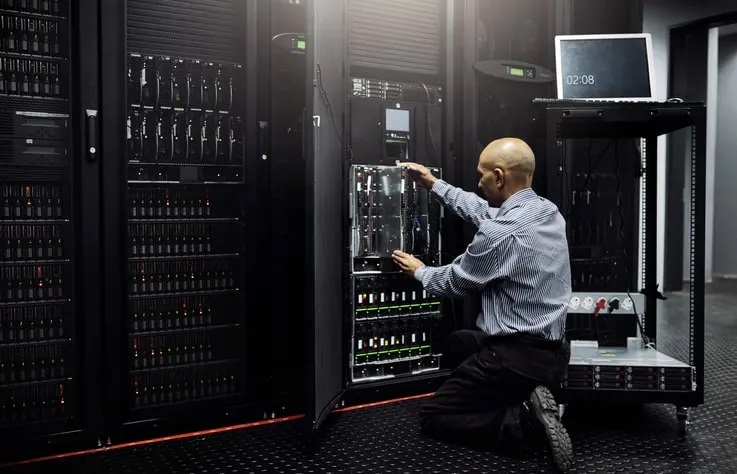Where data powers everything from businesses to personal interactions, virtual and dedicated servers have emerged as the unsung heroes.
But with great power comes great responsibility. Imagine these servers as fortresses guarding invaluable treasures.
Our journey into the “Cyber Security Essentials for Virtual and Dedicated Servers” realm begins here. Brace yourself to uncover the vital strategies that shield these modern bastions from the relentless barrage of cyber threats. Your data’s sanctuary depends on it.
Understanding Virtual and Dedicated Servers
Virtual Private Servers (VPS) are virtualized instances within a physical server created using virtualization technology. Each VPS operates independently and shares the same physical resources with other VPS instances.
Dedicated servers are physical machines devoted entirely to a single user or organization. They offer exclusive access to all server resources, providing high performance, control, and customization levels.
Differentiating Between VPS and Dedicated Servers
Virtual Private Servers (VPS)
Benefits
- Cost-Efficiency: VPS is more affordable than dedicated servers.
- Scalability: VPS can be easily scaled up or down based on needs.
- Resource Allocation: VPS provides a balance between resource allocation and cost.
Drawbacks
- Resource Sharing: Performance can be impacted by other VPS instances sharing the same server.
- Limited Control: Users have less control over server configuration than dedicated servers.
Dedicated Servers
Benefits
- Performance: Exclusive access to resources ensures consistently high performance.
- Customization: Complete control over server configuration and software.
- Security: Enhanced security due to isolation from other servers.
Drawbacks
- Cost: Dedicated servers are more expensive than VPS hosting.
- Maintenance: Users need technical expertise or dedicated IT staff for server management.
Common Cyber Security Threats: Safeguarding Virtual and Dedicated Servers
Let’s get into some of the biggest cyber threats and potential consequences.
Prevalent Cyber Threats
Malicious software, such as viruses, Trojans, and ransomware, can infiltrate servers through various means, compromising data and disrupting operations.
Distributed Denial of Service attacks overwhelm servers with massive traffic, causing downtime and service disruption.
Cybercriminals use phishing emails to trick users into revealing sensitive information, potentially leading to unauthorized server access.
Potential Consequences
Successful cyber-attacks can lead to sensitive data leaks, exposing customer information, financial records, and business secrets. Cyber attacks can lead to financial losses due to theft of funds, legal liabilities, and costs associated with recovery and repairs.
Successful attacks tarnish a business’s reputation, eroding customer trust and loyalty. Data breaches may result in non-compliance with data protection regulations, leading to legal consequences.
Cyber Security Measures for Virtual and Dedicated Servers
This section of the article will cover the most effective cyber security measures.
Server Hardening: Bolstering Defenses
Server hardening involves implementing security measures to reduce vulnerabilities and enhance server resilience against potential threats. Virtual servers require turning off unnecessary services, configuring strong access controls, and securing hypervisor platforms to prevent unauthorized access.
For dedicated servers, the hardening process involves tightening OS security settings, limiting user privileges, and securing physical access to the server.
Regular Software Updates: Shielding Vulnerabilities
Keeping server software up to date is crucial as it patches known vulnerabilities and minimizes security flaws. Regularly update the virtualization software, guest OS, and applications to mitigate potential risks associated with unpatched software.
Firewall Configuration: Building a Protective Barrier
Firewalls are a barrier between your server and potential threats, controlling incoming and outgoing network traffic. Configure virtual server firewalls to filter traffic between virtual machines and isolate them from possible attacks. On dedicated servers, establish firewall rules to filter traffic based on ports, protocols, and IP addresses, bolstering protection.
Intrusion Detection and Prevention Systems (IDPS): Active Threat Mitigation
IDPS are tools that detect and respond to unauthorized access and malicious server activities. Implement virtual IDPS solutions to monitor virtualized traffic, detect anomalies, and respond to threats. On dedicated servers, deploy IDPS to monitor network traffic, detect intrusion attempts, and prevent unauthorized access.
Data Encryption: Safeguarding Sensitive Information
Encrypting data at rest and in transit ensures that the stolen data remains unreadable even if a breach occurs. Encrypt virtual machine disks and ensure secure communication between VMs to maintain data integrity. Use full-disk encryption to protect data on dedicated servers, preventing unauthorized access to sensitive information.
User Access Control and Authentication
Access controls and authentication can be a great way to prevent cyber attacks, so let’s dive deeper into each.
Role-Based Access Control (RBAC)
Role-Based Access Control is a system that assigns specific permissions and privileges to users based on their roles within an organization. It provides a structured approach to managing user access.
RBAC enhances security by ensuring users access only the resources necessary for their roles. It reduces the risk of unauthorized access and potential data breaches.
Multi-Factor Authentication (MFA)
Multi-factor authentication adds an extra layer of security beyond traditional password protection. It requires users to provide multiple forms of identification, significantly reducing the risk of unauthorized access.
MFA prevents unauthorized users from gaining access even with the correct password. This is crucial for protecting sensitive data and maintaining the integrity of server environments.
Enabling MFA involves adding additional authentication factors, such as a one-time code sent to a mobile device or biometric verification.
Conclusion
Cyber threats loom large, but armed with the proper knowledge, you can fortify your defenses. This article has unveiled a treasure trove of cyber security essentials from server hardening to encryption, access controls, and multi-factor authentication.
Remember, in this digital age, the guardianship of your data’s sanctuary rests in your hands. Embrace these strategies, for your server’s safety and your peace of mind depend on it.








Add Comment